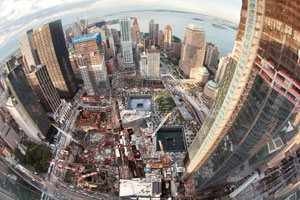 |
| Image courtesy Silverstein Properties |

On Wednesday, September 7, just days before the opening of the National September 11 Memorial in Lower Manhattan, New York Mayor Michael Bloomberg, master planner Daniel Libeskind, developer Larry Silverstein, and a host of other officials gathered at 7 World Trade Center to report on construction progress at the site. Almost a decade after the terrorist attacks, Silverstein was visibly pleased to tell a room filled with international press that, after many starts and stops, “every part of the new World Trade Center is under construction.”
Acknowledging past troubles, Bloomberg noted that “the road we’ve traveled over the past decade hasn’t been smooth and it hasn’t been straight.” However, suggesting that the site’s many stakeholders have ironed out the kinks, he added, “Daniel Libeskind’s master plan for this site is coming to life at a quickening pace.”
One World Trade Center, designed by Skidmore, Owings and Merrill, now stands at 80 stories, he said. 4 World Trade Center, designed by Maki and Associates, stands at 40 stories. Both buildings will top out by April next year, and open in 2013, said Silverstein.
Between those towers, foundation work has been completed for 2 World Trade Center and 3 World Trade Center, designed by Foster + Partners and Rogers Stirk Harbour + Partners, respectively, said Silverstein.
“The development of the Santiago Calatrava-designed transit hub, once marred by significant delays, is now under way,” said Bloomberg, noting that below-grade work has also begun for a performing arts center, to be designed by Frank Gehry. “We’re hopeful that the performing arts center’s construction will begin in earnest once the temporary PATH station that now occupies that space is removed in 2015,” he added.
Beyond the confines of the WTC site, Bloomberg noted that the surrounding neighborhood is flourishing. “There are now more businesses operating in Lower Manhattan than there were on September 10, 2001,” he said. “And there are now more people living in this neighborhood than at any time since 1920.”
Asked how all the construction compares to his original master plan, after years of changes and adjustments, Libeskind said “It’s almost identical.” But he did acknowledge that there has been plenty of negotiation along the way. “Really, if you examine the process, and all the stakeholders, to me, it’s amazing how we have all come together to create something that is harmonious, that has a meaning, that isn’t just a bunch of disconnected pieces, but really a collective new neighborhood,” he said.
Calling their combined efforts “a testament…to democracy,” Libeskind added, “there might be a division of labor, but there’s a unity of purpose, and a unity of spirit in rebuilding New York.”
